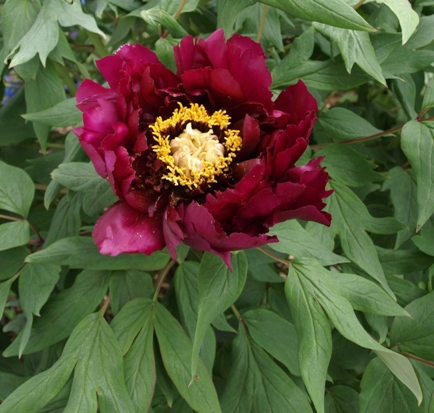Paeonia suffruticosa
Shrub peony ( Paeonia suffruticosa )
The shrub peony ( Paeonia suffruticosa ), also called Tree Peony, is a flowering plant in the genus of peonies (Paeonia ) within the family of peony plants ( Paeoniaceae ). It is native to China. Many species are used as ornamental plants.
- 6.1 Literature
- 6.2 Notes and references
Description
The shrub peony grows as a shrub that reaches heights of growth of about 1.5 meters, and occasionally of 3.0 meters and 5.0 meters in extreme cases, as a rule. With increasing age, the woody stem axis, thus they are well protected against frost in winter. The very long-lived shrub peony can reach an age of up to 60 years. The bark is brown - gray. The young shoots shows a reddish color, and later goes on in different green shades.
The alternate arranged leaves are stalked. The leaf blades are double in three parts. The leaf sections are oval, with a length from 4.5 to 8 cm and a width of 2.5 to 7 centimeters. Upper leaf surface and bottom are bare. The end portion are deeply three-lobed and these lobes are again two - or three-lobed or unlobed some. All lobes have a pointed upper end.
The flowering period extends depending on the location and game shape or form of culture from April to May or June. The flowers are individually terminally on the branches. There are five unequal, long elliptical bracts present. The hermaphrodite flowers in wild forms have a diameter of 10 to 17 centimeters and in some modern forms of up to 25 centimeters. There are five green sepals broadly ovate available. The flowers of the wild forms are simple, the cultivated forms of simple or filled. The colors of the petals are is in the wild forms white on pink and red to purple. In cultural forms are the colors of the petals are depending on the variety pink, red, purple or white, sometimes yellow. Simple flowers contain five to eleven petals that are obovate with a length of 5 to 8 centimeters and a width of 4.2 to 6 inches with irregular incised upper ends. You have numerous stamens. The approximately 1.3 inches long stamens are pink to purple with white base. The yellow dust bag are long - ellipsoid with a length of about 4 millimeters. During anthesis, the carpels are completely enveloped by the leathery, purple discus, which is serrated or lobed at the top. There are usually five, rarely more, free, densely woolly hairy carpels present. The scars are red.
There are five most densely brown - yellow woolly hairy follicles together. The fruits ripen in August.
The chromosome number is 2n = wild-type 10
Occurrence
The natural home of the shrub peony is China. Main habitat of the wild form is the high mountains, which is why it is very resistant. Refined forms are to be found in gardens around the world. They prefer sunny places.
History and taxonomy
Records of this species there are in China for more than 2000 years. In the 8th century it has been cultivated for ornamental purposes, and were bred with filled shapes and larger flowers. It is an important symbol of Chinese culture and as牡丹" mǔdān " known. In the 18th century this species was sent to the British naturalist Sir Joseph Banks first time to Europe.
The scientific description was in 1804 by Henry Charles Andrews in Botanist 's Repository, for new, and rare plants, 6, Box 373
There are about two subspecies of Paeonia suffruticosa:
- Paeonia suffruticosa Andrews subsp. suffruticosa
- Paeonia suffruticosa subsp. yinpingmudan D.Y.Hong
No more Paeonia suffruticosa include:
- Paeonia suffruticosa subsp. rockii SGHaw & Lauener is now a synonym of Paeonia rockii ( SGHaw & Lauener ) T.Hong & JJLi subsp. rockii
- Paeonia suffruticosa var linyanshanii JJHalda is now a synonym of Paeonia rockii subsp. linyanshanii ( J.J.Halda ) Hong & G.L.Ost
- Paeonia suffruticosa Andrews var jishanensis ( T.Hong & WZZhao ) Halda, P. suffruticosa subsp. spontanea ( Rehder ) SGHaw & Lauener, P. suffruticosa var spontanea Rehder is now a synonym of Paeonia jishanensis T.Hong & WZZhao
Use
Ornamental plant
Varieties of shrub peony used in gardens as an ornamental plant. They are characterized by their high growth and its large flowers very conspicuous. She is frugal and thrives in full sun, but also slightly shaded places. Normal winter they can easily survive. In very cold temperatures during the first shoot, it may lead to frost damage.
For planted in ornamental gardens shrub peony is Paeonia suffruticosa often by hybrids.
Toxicity, therapeutic effect
Plant parts contain slightly toxic ester compounds for humans.
On the other hand, it is cultivated as a medicinal plant in China due to the anticonvulsant effect of constituents of the root bark.










